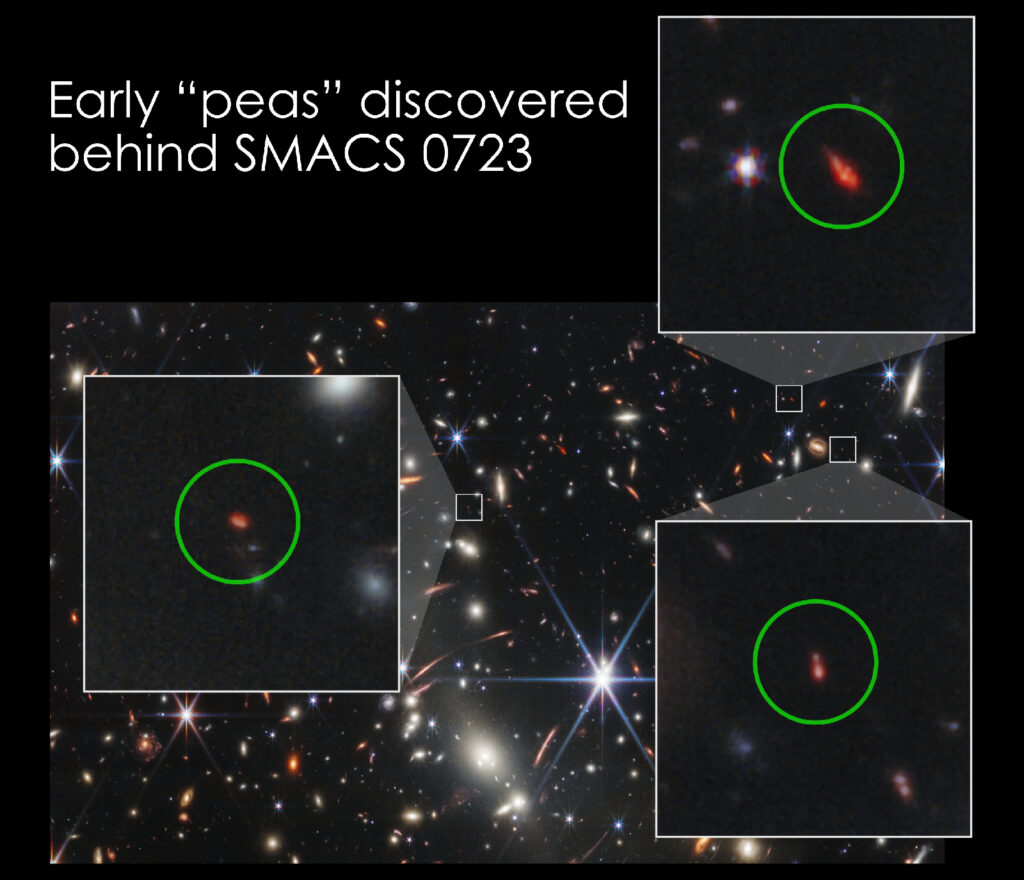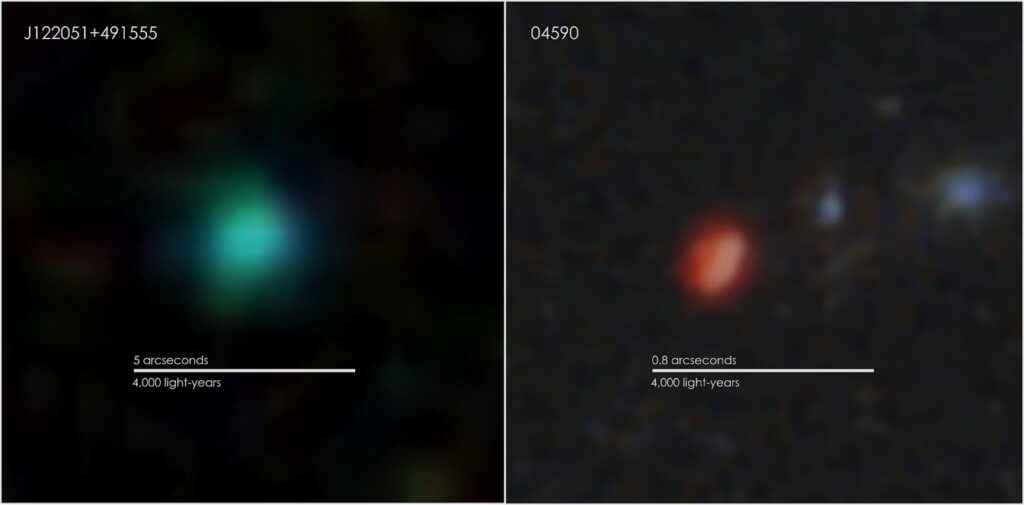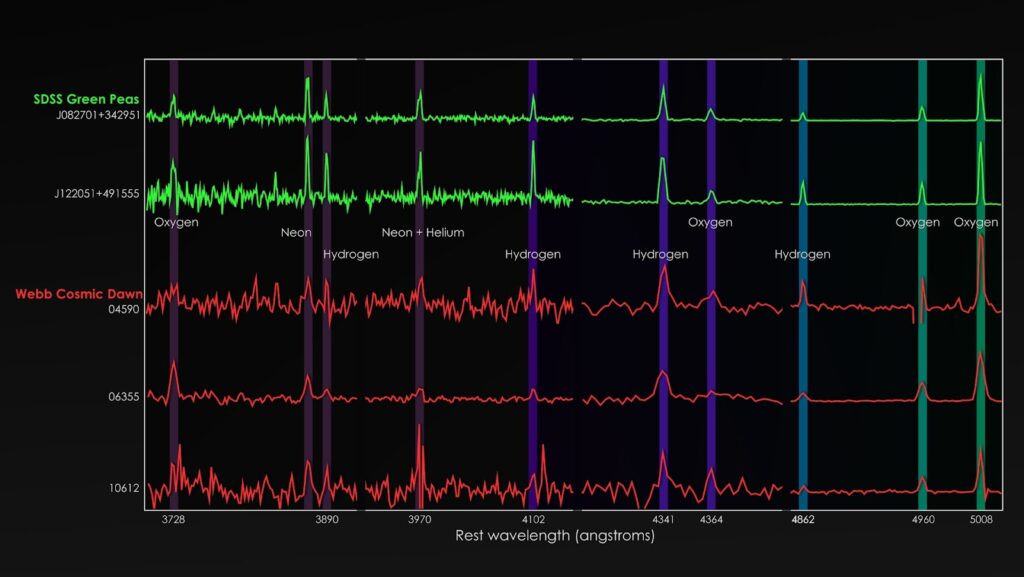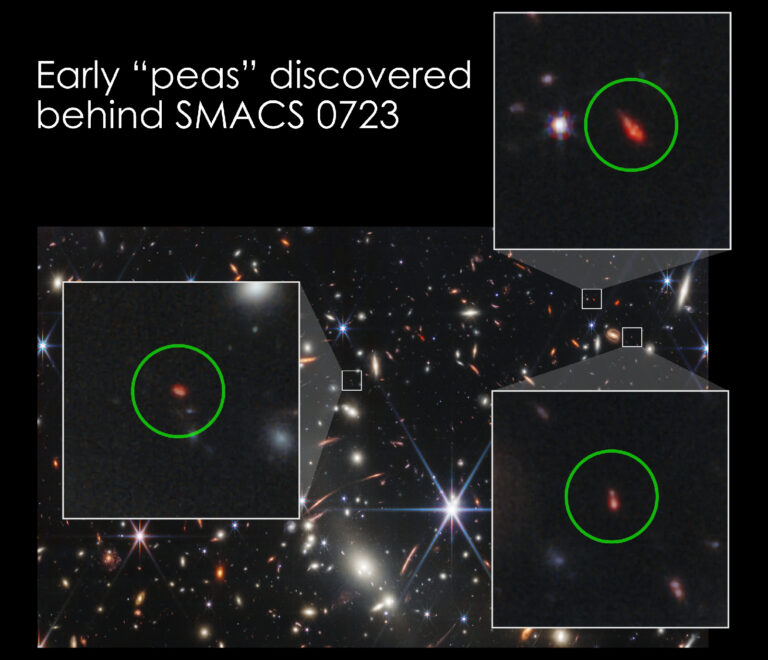NASA’s Webb Telescope Discovers Connections Between Nearby and Faraway Galaxies
A recent investigation of distant galaxies captured by NASA’s James Webb Space Telescope reveals that they are very similar to “green peas,” a rare type of tiny galaxies in our cosmic backyard, and are also very young.
We can observe that these early galaxies contain what may be the most primordial galaxy seen to far thanks to the comprehensive chemical traces they left behind.
The findings were presented at the 241st meeting of the American Astronomical Society in Seattle by James Rhoads, an astrophysicist at NASA’s Goddard Flight Centre in Greenbelt, Maryland. “At the same time, we can connect these galaxies from the beginning of the universe to similar ones nearby, which we can study in much greater detail,” he said.
A paper describing the results, led by Rhoads, was published Jan. 3 in The Astrophysical Journal Letters.

Volunteers working on Galaxy Zoo, a project where citizen scientists assist categorize galaxies in photographs starting with those from the Sloan Digital Sky Survey, made the discovery and naming of green pea galaxies in 2009.
Small, rounded, unresolved specks with a particular green hue that were distinguished as peas in the survey’s composite pictures as well as a characteristic of the galaxies themselves.

Because a significant portion of the light in green pea galaxies comes from brilliantly blazing gas clouds, these galaxies have distinctive hues.
Unlike stars, which generate a rainbow-like spectrum of continuous color, gases release light at distinct wavelengths. Peas are generally only 5,000 light-years wide, or roughly 5% the size of our Milky Way galaxy. They are also rather small.
According to Keunho Kim, a postdoctoral researcher at the University of Cincinnati and a member of the analytic team, “Peas may be little, but their star-formation activity is extraordinarily powerful for their size, thus they create brilliant ultraviolet light.” “It’s obvious that they both have this trait thanks to ground-based study on early star-forming galaxies and ultraviolet photos of green peas from Hubble.”
The deepest and brightest infrared image of the distant cosmos ever seen was released in July 2022 by NASA and its Webb mission collaborators. It showed hundreds of galaxies in and behind the SMACS 0723 galaxy cluster. Because of its bulk, the cluster acts as a gravitational lens, enlarging and warping the image of background galaxies.
A trio of compact infrared objects that seemed to be distant cousins of green peas were among the weakest galaxies behind the cluster. The most distant of these three galaxies was magnified by around ten times, giving the telescope a huge boost from nature in addition to its unmatched skills.
In addition to taking pictures of the cluster, Webb also used its Near-Infrared Spectrograph (NIRSpec) instrument to record the spectra of a few of the nearby galaxies.
The typical characteristics released by oxygen, hydrogen, and neon lined up in a striking likeness to those seen from neighboring green peas when Rhoads and his colleagues studied these observations and adjusted them for the wavelength stretch caused by the expansion of space.

The Webb spectra also allowed for the first measurement of the oxygen content in these cosmic dawn galaxies.
Lighter elements like hydrogen and helium are converted into heavier ones by stars as they generate energy. These heavier elements are integrated into the gas that creates the following stellar generations when stars burst or shed their outer layers at the end of their lifetimes, continuing the process. Over the course of the universe’s existence, stars have slowly improved it.
Two of the Webb galaxies had oxygen levels that are roughly 20% lower than those of the Milky Way. Despite making up fewer than 0.1% of the nearest galaxies seen by the Sloan survey, they resemble ordinary green peas. Even more peculiarity is seen in the third analyzed galaxy.
“We’re seeing these objects as they existed up to 13.1 billion years ago, when the universe was about 5% its current age,” said Goddard researcher Sangeeta Malhotra. “And we see that they are young galaxies in every sense – full of young stars and glowing gas that contains few chemical products recycled from earlier stars. Indeed, one of them contains just 2% the oxygen of a galaxy like our own and might be the most chemically primitive galaxy yet identified.”
Airbus Industries created NIRSpec for the European Space Agency. It is capable of recording the spectra of up to 100 different things at once thanks to its array of roughly 500,000 microshutters, which are small doors that can be opened or closed to admit or block light. NASA created the microshutter array and detector subsystems.
Provided by NASA Webb
Do not forget to share your opinion with us to provide you with the best posts !




0 Comments